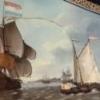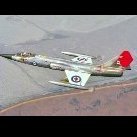-
Posts
4,564 -
Joined
-
Last visited
Reputation Activity
-
 Blue Ensign got a reaction from Mr Whippy in HMS Pegasus by Blue Ensign - FINISHED - Amati/Victory Models - 1:64 scale
Blue Ensign got a reaction from Mr Whippy in HMS Pegasus by Blue Ensign - FINISHED - Amati/Victory Models - 1:64 scale
The casing of Pegasus took place yesterday, one of the most stressful operations since constructing the Headworks.
Slipping the cover over Pegasus with only a few mm clearance each side of the Main Studding Booms ends and Jib boom was scary to say the least.
Still all done now, and here she is in her designated place.
Moving on now, to what not quite decided.
B.E.
-
 Blue Ensign got a reaction from Freebird in HMS Pegasus by Blue Ensign - FINISHED - Amati/Victory Models - 1:64 scale
Blue Ensign got a reaction from Freebird in HMS Pegasus by Blue Ensign - FINISHED - Amati/Victory Models - 1:64 scale
The casing of Pegasus took place yesterday, one of the most stressful operations since constructing the Headworks.
Slipping the cover over Pegasus with only a few mm clearance each side of the Main Studding Booms ends and Jib boom was scary to say the least.
Still all done now, and here she is in her designated place.
Moving on now, to what not quite decided.
B.E.
-
 Blue Ensign got a reaction from Kathy Teel in HMS Pegasus by Blue Ensign - FINISHED - Amati/Victory Models - 1:64 scale
Blue Ensign got a reaction from Kathy Teel in HMS Pegasus by Blue Ensign - FINISHED - Amati/Victory Models - 1:64 scale
The casing of Pegasus took place yesterday, one of the most stressful operations since constructing the Headworks.
Slipping the cover over Pegasus with only a few mm clearance each side of the Main Studding Booms ends and Jib boom was scary to say the least.
Still all done now, and here she is in her designated place.
Moving on now, to what not quite decided.
B.E.
-
 Blue Ensign got a reaction from Sooty in HMS Pegasus by Blue Ensign - FINISHED - Amati/Victory Models - 1:64 scale
Blue Ensign got a reaction from Sooty in HMS Pegasus by Blue Ensign - FINISHED - Amati/Victory Models - 1:64 scale
The casing of Pegasus took place yesterday, one of the most stressful operations since constructing the Headworks.
Slipping the cover over Pegasus with only a few mm clearance each side of the Main Studding Booms ends and Jib boom was scary to say the least.
Still all done now, and here she is in her designated place.
Moving on now, to what not quite decided.
B.E.
-
 Blue Ensign reacted to Mirabell61 in HMS Pegasus by Blue Ensign - FINISHED - Amati/Victory Models - 1:64 scale
Blue Ensign reacted to Mirabell61 in HMS Pegasus by Blue Ensign - FINISHED - Amati/Victory Models - 1:64 scale
Wow B.E.
what a lovely display, and that beautiful casing. Love that little side table she is standing on.
Congratulations to your wonderful rounding up of the project, an awsome looking piece of maritime art...
Nils
-
 Blue Ensign got a reaction from WalrusGuy in HMS Pegasus by Blue Ensign - FINISHED - Amati/Victory Models - 1:64 scale
Blue Ensign got a reaction from WalrusGuy in HMS Pegasus by Blue Ensign - FINISHED - Amati/Victory Models - 1:64 scale
The casing of Pegasus took place yesterday, one of the most stressful operations since constructing the Headworks.
Slipping the cover over Pegasus with only a few mm clearance each side of the Main Studding Booms ends and Jib boom was scary to say the least.
Still all done now, and here she is in her designated place.
Moving on now, to what not quite decided.
B.E.
-
 Blue Ensign got a reaction from Captain Poison in HMS Pegasus by Blue Ensign - FINISHED - Amati/Victory Models - 1:64 scale
Blue Ensign got a reaction from Captain Poison in HMS Pegasus by Blue Ensign - FINISHED - Amati/Victory Models - 1:64 scale
The casing of Pegasus took place yesterday, one of the most stressful operations since constructing the Headworks.
Slipping the cover over Pegasus with only a few mm clearance each side of the Main Studding Booms ends and Jib boom was scary to say the least.
Still all done now, and here she is in her designated place.
Moving on now, to what not quite decided.
B.E.
-
 Blue Ensign reacted to rafine in Halifax by rafine - FINISHED - The Lumberyard - 1:48 - semi-scratch schooner
Blue Ensign reacted to rafine in Halifax by rafine - FINISHED - The Lumberyard - 1:48 - semi-scratch schooner
I've now completed making and mounting the bow cant frames and hawse timbers. As at the stern, some discrepancies between the parts, jig and drawings required some tweaks and adjustments to be made. As with the previous work on the framing, I've done the rough fairing of the outside of the hull. For the most part, it seems to fair up well. The exception is at the upper portion of the frames ( at the bottom of the photos because of the upside down construction), where it seems that a few of the notches in the jig are misaligned, causing some low areas. This will be corrected by adding boxwood strip to the outside of the affected frames and then sanding them fair. There should be no visible evidence of this because those areas are to be planked over anyway.
Next up is the framing of the stern, starting with the transoms and stern timbers.
Bob
-
 Blue Ensign reacted to rafine in Halifax by rafine - FINISHED - The Lumberyard - 1:48 - semi-scratch schooner
Blue Ensign reacted to rafine in Halifax by rafine - FINISHED - The Lumberyard - 1:48 - semi-scratch schooner
I've now completed the stern cant frames. These presented two problems. The first was the expected difficulty of cutting and sanding the required angles to get a proper fit. That went reasonably well. The second, however, was more troublesome. The aft most frame did not match the plan and had to be tweaked to get it to fit. it remains to be seen after final fairing and assembly of the stern framing whether this will turn out correctly, or whether I will need to remove it and make a new pair of frames. As I have been doing, I did some rough fairing to get a feel for the fit of the frames.
I'm now working on the bow cant frames.
Bob
-
 Blue Ensign reacted to MEDDO in Halifax 1768 by MEDDO - FINISHED - Lauck Street Shipyard - 1/4" scale
Blue Ensign reacted to MEDDO in Halifax 1768 by MEDDO - FINISHED - Lauck Street Shipyard - 1/4" scale
Was able to use a hair dryer to very gently bend the transom so it would fit flush on the back of the ship. And now it's just slow going cutting out all the windows. I am happy that the Stern posts are lining up with the windows very nicely.
-
 Blue Ensign reacted to MEDDO in Halifax 1768 by MEDDO - FINISHED - Lauck Street Shipyard - 1/4" scale
Blue Ensign reacted to MEDDO in Halifax 1768 by MEDDO - FINISHED - Lauck Street Shipyard - 1/4" scale
So first attempt at silver soldering went ok. Was difficult trying to get the little tubes in the correct orientation to the strip. They kept coming out crooked. It was easy to just reheat it and move em a bit though. Here are the rough gudgeon prior to cleaning them up.
Every day acquiring new skills
-
 Blue Ensign reacted to egkb in HM Schooner Ballahoo by egkb - FINISHED - Caldercraft - 1:64 Scale - First Proper Wood Build
Blue Ensign reacted to egkb in HM Schooner Ballahoo by egkb - FINISHED - Caldercraft - 1:64 Scale - First Proper Wood Build
Hi Gang ..
At long last I hear you say.. I have an actual Ballahoo Update !
I have a few days off and decided to get back at the Building Table .. have been assessing her this past few days in anticipation of the 'few days off' and saw that in reality Ballahoo is not too far from being finished ! (I know I know .. there is the rigging to do, but let's face it in comparison to many if not most of the builds on here Little Wee Ballahoo isn't the most 'Rigged' vessel on display
Anyhoo .. To Business !
I tidied the rigging for the Guns and made up the Rope Coils, treating them with diluted pva to keep them in place and in shape.
Next up was the 'strops' for the Tiller (the lines to prevent it moving) these proved to be somewhat tricky affairs as they needed to be tight and keep the tiller arm centered! easier said then done with my limited ability (you may notice I have a small bulldog clip holding 2 pieces of flat wood each side of the rudder to prevent accidental knocks which would otherwise I'm sure rip the tiller from the Rudder Head, now that the Strops are in position)
Then I moved onto the various Blocks near the top of the Mast's, and the Cleats towards the deck..
The Masts are only dry fitted by the way but I'm quiet near the point where they will be permanently fitted so I can get on with the various Stays etc ..
Photo Time ..
All The Best Folks and Thanks For Stopping By The Slooooowest Build on MSW
Eamonn
-
 Blue Ensign reacted to egkb in HM Schooner Ballahoo by egkb - FINISHED - Caldercraft - 1:64 Scale - First Proper Wood Build
Blue Ensign reacted to egkb in HM Schooner Ballahoo by egkb - FINISHED - Caldercraft - 1:64 Scale - First Proper Wood Build
Hi Gang ... Just thought I'd better pop along and let you know what I've been up to .. cos 'no' I haven't been 'skiving off' .. I have been tipping and tapping along on Ballahoo (The Mast Hoops are ready to install.. I was experimenting with different material and ultimately came back to the ones I made earlier, except that I painted them a more timber colour.. ) Anyhoo with the brighter days I decided to do something ..
That 'something' was to finish off a build I had started many many years before Ballahoo (think 15 to 20 in fact).. well before I ever attempted a Wooden Boat in fact.. she is an adapted French 74 (originally the kit 'Le Superbe' I think) made into a 'Prize' of the RN .. I was rigging her correctly using Lees and it was taking forever (this is about 15 years ago btw) .. Well .. I have been pondering a possibility this past year or two and decided to act on it a few days ago .. I 'cut her down' that is I chopped the masts to a centimeters above deck height thus pretty much finishing the build in one fell swoop (at least she is as finished as she will ever be.. I have no plans for instance to add the Gun Port Lids, to be honest they are long gone after an enthusiastic room clean out ) .. I will be ordering a Glass Case shortly (a lot cheaper now, in fact it will be an upturned Fish Tank made to measure by local glass merchants )
As Usual Thanks For Stopping By, Normal Ballahoo Service Will Be Resumed Shortly (Promise)
All The Very Best Folks
Eamonn
Right .. Enough Talk .. Time for some Photos
-
 Blue Ensign reacted to MEDDO in HMS Pegasus by Blue Ensign - FINISHED - Amati/Victory Models - 1:64 scale
Blue Ensign reacted to MEDDO in HMS Pegasus by Blue Ensign - FINISHED - Amati/Victory Models - 1:64 scale
That's a great picture. It really gives a great representation of the scale of the model.
-
 Blue Ensign got a reaction from Mr Whippy in HMS Pegasus by Blue Ensign - FINISHED - Amati/Victory Models - 1:64 scale
Blue Ensign got a reaction from Mr Whippy in HMS Pegasus by Blue Ensign - FINISHED - Amati/Victory Models - 1:64 scale
For those who may be vaguely curious about the face behind the model, here's yours truly posing with Pegasus before she is cased.
B.E.
-
 Blue Ensign got a reaction from Joseph_M in HMS Pegasus by Blue Ensign - FINISHED - Amati/Victory Models - 1:64 scale
Blue Ensign got a reaction from Joseph_M in HMS Pegasus by Blue Ensign - FINISHED - Amati/Victory Models - 1:64 scale
For those who may be vaguely curious about the face behind the model, here's yours truly posing with Pegasus before she is cased.
B.E.
-
 Blue Ensign reacted to donrobinson in HMS Pegasus by Blue Ensign - FINISHED - Amati/Victory Models - 1:64 scale
Blue Ensign reacted to donrobinson in HMS Pegasus by Blue Ensign - FINISHED - Amati/Victory Models - 1:64 scale
Great to meet you B.E.
-
 Blue Ensign reacted to Mirabell61 in HMS Pegasus by Blue Ensign - FINISHED - Amati/Victory Models - 1:64 scale
Blue Ensign reacted to Mirabell61 in HMS Pegasus by Blue Ensign - FINISHED - Amati/Victory Models - 1:64 scale
Hi B.E.
nice to have a face along with the the fellow builder`s lovely model
Nils
-
 Blue Ensign got a reaction from WalrusGuy in HMS Pegasus by Blue Ensign - FINISHED - Amati/Victory Models - 1:64 scale
Blue Ensign got a reaction from WalrusGuy in HMS Pegasus by Blue Ensign - FINISHED - Amati/Victory Models - 1:64 scale
For those who may be vaguely curious about the face behind the model, here's yours truly posing with Pegasus before she is cased.
B.E.
-
 Blue Ensign got a reaction from p.hoek in HMS Pegasus by Blue Ensign - FINISHED - Amati/Victory Models - 1:64 scale
Blue Ensign got a reaction from p.hoek in HMS Pegasus by Blue Ensign - FINISHED - Amati/Victory Models - 1:64 scale
For those who may be vaguely curious about the face behind the model, here's yours truly posing with Pegasus before she is cased.
B.E.
-
 Blue Ensign got a reaction from GrandpaPhil in HMS Pegasus by Blue Ensign - FINISHED - Amati/Victory Models - 1:64 scale
Blue Ensign got a reaction from GrandpaPhil in HMS Pegasus by Blue Ensign - FINISHED - Amati/Victory Models - 1:64 scale
For those who may be vaguely curious about the face behind the model, here's yours truly posing with Pegasus before she is cased.
B.E.
-
 Blue Ensign got a reaction from amateur in HMS Pegasus by Blue Ensign - FINISHED - Amati/Victory Models - 1:64 scale
Blue Ensign got a reaction from amateur in HMS Pegasus by Blue Ensign - FINISHED - Amati/Victory Models - 1:64 scale
For those who may be vaguely curious about the face behind the model, here's yours truly posing with Pegasus before she is cased.
B.E.
-
 Blue Ensign got a reaction from Haliburton in HMS Pegasus by Blue Ensign - FINISHED - Amati/Victory Models - 1:64 scale
Blue Ensign got a reaction from Haliburton in HMS Pegasus by Blue Ensign - FINISHED - Amati/Victory Models - 1:64 scale
For those who may be vaguely curious about the face behind the model, here's yours truly posing with Pegasus before she is cased.
B.E.
-
 Blue Ensign got a reaction from billocrates in HMS Pegasus by Blue Ensign - FINISHED - Amati/Victory Models - 1:64 scale
Blue Ensign got a reaction from billocrates in HMS Pegasus by Blue Ensign - FINISHED - Amati/Victory Models - 1:64 scale
For those who may be vaguely curious about the face behind the model, here's yours truly posing with Pegasus before she is cased.
B.E.
-
 Blue Ensign got a reaction from yvesvidal in HMS Pegasus by Blue Ensign - FINISHED - Amati/Victory Models - 1:64 scale
Blue Ensign got a reaction from yvesvidal in HMS Pegasus by Blue Ensign - FINISHED - Amati/Victory Models - 1:64 scale
For those who may be vaguely curious about the face behind the model, here's yours truly posing with Pegasus before she is cased.
B.E.



.thumb.jpg.62d1d69fed1f32364417cb1f9cdeb009.jpg)




